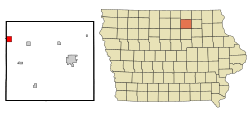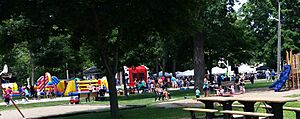Nora Springs, Iowa facts for kids
Quick facts for kids
Nora Springs, Iowa
|
|
|---|---|

Location of Nora Springs, Iowa
|
|
| Country | |
| State | |
| Counties | Floyd, Cerro Gordo |
| Area | |
| • Total | 2.24 sq mi (5.81 km2) |
| • Land | 2.22 sq mi (5.74 km2) |
| • Water | 0.03 sq mi (0.07 km2) |
| Elevation | 1,086 ft (331 m) |
| Population
(2020)
|
|
| • Total | 1,369 |
| • Density | 617.78/sq mi (238.48/km2) |
| Time zone | UTC-6 (Central (CST)) |
| • Summer (DST) | UTC-5 (CDT) |
| ZIP code |
50458
|
| Area code(s) | 641 |
| FIPS code | 19-56910 |
| GNIS feature ID | 0459546 |
Nora Springs is a small city in Iowa, a state in the United States. It's special because it's located in two different counties: Cerro Gordo and Floyd. The city sits right by the Shell Rock River. In 2020, about 1,369 people lived there. The part of Nora Springs in Cerro Gordo County is also considered part of the larger Mason City area.
Contents
History of Nora Springs
Nora Springs was founded a long time ago, in 1857. It officially became a city in 1875. When it was first started, it had a different name: Woodstock.
How Nora Springs Got Its Name
A pioneer named Edson Gaylord convinced a wealthy man, Edward Greeley, to visit the town. Greeley agreed to buy and improve a gristmill (a mill for grinding grain) and some land. But he had one condition: the town had to change its name from Woodstock to Elnora, in honor of a woman he once knew.
Edson Gaylord wanted the town to be called "Springs." So, they reached a compromise. Woodstock became Elnora Springs, which was quickly shortened to Nora Springs. After this, Greeley went on a trip and later sold the land back to Gaylord. He never returned to Nora Springs.
Moving the Downtown Area
When Nora Springs was first built, its main business area was near the gristmill. This was at the western end of what is now Sixth Street NW. Later, two different railroads started building tracks a few blocks south of the original town center. Because of this, the downtown area slowly moved closer to the new train lines. The old business district became known as "Old Town."
The gristmill eventually closed down and was taken apart in the late 1950s. However, the millrace (the channel that directs water to the mill) and the dam are still there. In recent years, the city has turned this area into a beautiful park. A footbridge was built over the Shell Rock River dam in 2019, making it a great spot to visit.
Geography and Location
Nora Springs is located at specific coordinates: 43.144010 degrees North and -93.008929 degrees West. These numbers help pinpoint its exact spot on a map.
The city covers a total area of about 2.22 square miles (5.74 square kilometers). Most of this area, about 2.19 square miles (5.67 square kilometers), is land. A small part, about 0.03 square miles (0.07 square kilometers), is water.
Population and People
The number of people living in Nora Springs has changed over the years. In 1880, there were 617 residents. The population grew to 1,209 by 1900. It reached its highest point in 1980 with 1,572 people. By 2020, the population was 1,369.
Who Lives in Nora Springs?
In 2020, there were 1,369 people living in Nora Springs. There were 574 households, which are groups of people living together in one home.
Most people in Nora Springs are White (about 92.5%). There are also smaller groups of Black or African American, Native American, Asian, and Pacific Islander residents. About 3.9% of the population identified as Hispanic or Latino.
The average age of people in Nora Springs was 41.4 years old. About 25.3% of residents were under 20 years old, and 22.2% were 65 years or older. The city has a slightly higher number of females (51.8%) than males (48.2%).
Nora Springs Buffalo Days
Every year, during the last week of June, Nora Springs celebrates "Buffalo Days." This is a fun festival for everyone!
What Happens at Buffalo Days?
The festivities include a big parade that winds through the town. At Boulder Park, there's lots of entertainment, including food vendors selling tasty treats and inflatable rides for kids to enjoy. Other popular activities include a 5K Run/Walk, where people can exercise and have fun, and games of Bingo. The Fire Department also hosts a "Fireman's Ball" in the evening, which is a dance party for the community.
Education in Nora Springs
Public schools in Nora Springs are part of the Central Springs Community School District. This district was formed in 2011 when two smaller school districts merged. The school teams are known as the Central Springs Panthers.
School Locations
- All high school students (grades 9-12) attend school at the Manly site.
- Elementary students (grades K-3) from the Plymouth, Manly, and Hanlontown areas also go to the Manly site.
- All middle school students (grades 4-8) attend school at the Nora Springs site.
- Elementary students (grades K-3) from the Nora Springs and Rock Falls areas, and from the community of Portland, also go to the Nora Springs site.
The school colors are black and blue, and their mascot is a panther.
Notable People from Nora Springs
Many interesting people have connections to Nora Springs:
- Louis Bauman: A minister, writer, and speaker who was born in Nora Springs.
- Arthur Gratias: An Iowa State Senator, farmer, and educator who was born in Nora Springs.
- John P. Gregg: A college football coach for LSU and a quarterback for Wisconsin. He passed away in Nora Springs.
- Howard B. Rooks: An Electrical Engineer who held 10 U.S. Patents. He was born and grew up in Nora Springs.
See also
 In Spanish: Nora Springs (Iowa) para niños
In Spanish: Nora Springs (Iowa) para niños



